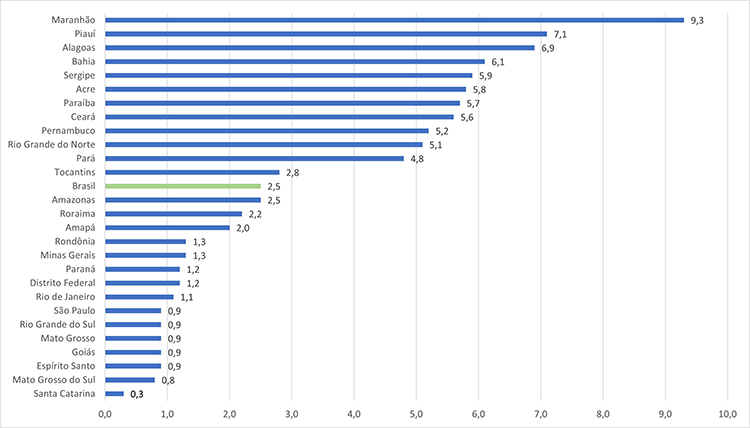Quarterly Continuous PNAD: unemployment drops in 18 of the 27 Federation Units in Q2 2025
August 15, 2025 09h00 AM | Last Updated: August 15, 2025 07h03 PM
The unemployment rate in the country in the second quarter of 2025 (5.8%) was the lowest in the time series initiated in 2012. Against Q1 2025, the unemployment rate dropped in 18 of the 27 Federation Units and was stable in the other nine. The highest rates were found in Pernambuco (10.4%), Bahia (9.1%) and the Federal District (8.7%) and the lowest, in Santa Catarina (2.2%), Rondônia (2.3%) and Mato Grosso (2.8%).
The unemployment rate (7.0%) was 4.8% for men and 6.9% for women in the second quarter of 2025. By color or race, this rate was below the national average for white persons (4.8%) and above average for black (7.0%) and brown persons (6.4%).
The unemployment rate among persons with incomplete high school (9.4%) was higher than that of the other levels of schooling analyzed. Among persons with incomplete higher education, the rate was 5.9%, almost twice as thar observed for complete higher education (3.2%).
In the second quarter of 2025, the composite underutilization rate (percentage of unemployed persons, time-related underemployed persons and persons in the potential workforce in relation to expanded workforce) was 14.4%. Piauí (30.2%) recorded the highest rate, with Bahia (27,0%) and Sergipe (26,0%) following it. The lowest rates were those of Santa Catarina (4.4%), Mato Grosso (6.8%) and Espírito Santo (7.1%).
In Q2 2025, 1.3 million persons had been searching for work for two or more year, the lowest figure in the series for a second semester since 2014 (1.2 million). This indicator decreased 23.6% against the second quarter of 2024.
The percentage of discouraged persons (against the population in the workforce or the discouraged population) in the country in Q2 2025 was 2.5%. Maranhão (9.3%), Piauí (7.1%) and Alagoas (6.9%) had the highest percentages, whereas the lowest were in Santa Catarina (0.3%) and Mato Grosso do Sul (0.8%). Then came Espírito Santo, Goiás, Mato Grosso, Rio Grande do Sul and São Paulo (with 0.9%).
In Brazil, the percentage of workers with a formal contract in the private sector was 74.2% in the second quarter of 2025. The highest percentages of workers with a formal contract were in Santa Catarina (87.4%), São Paulo (82.9%) and Rio Grande do Sul (81.2%), and the lowest were in Maranhão (53.1%), Piauí (54.5%) and Paraíba (54.6%).
The percentage of self-employed persons in the country was 25.2%. The highest percentages came from Rondônia (35.3%), Maranhão (31.8%) and Amazonas (30.4%) and the lowest, from the Federal District (18.6%), Tocantins (20.4%) and Mato Grosso do Sul (21.4%).
The informality rate for Brazil reached 37.8% of the employed population. The highest rates were those of Maranhão (56.2%), Pará (55.9%) and Bahia (52.3%) and the lowest, of Santa Catarina (24.7%), Federal District (28.4%) and São Paulo (29.2%).
Usual real monthly earnings amounted to R$ 3,477. there were increases in both comparisons: against the immediately previous quarter (R$ 3,440) and against the same quarter in 2024 (R$ 3,367). In the quarterly comparison, the Southeast (R$ 3,914) was the only Major Region with a statistically significant increase in earnings, whereas in the other ones there was stability. Against Q 2 2024, earnings increased in the Southeast and in the South (R$ 3,880), with stability in the other Major Regions.
From Q1 to Q2 2025, the unemployment rate dropped in 18 of the 27 Federation Units and remained stable in the other nine. The highest rates were those of Pernambuco (10.4%), Bahia (9.1%) and the Federal District (8.7%) and the lowest, those of Santa Catarina (2.2%), Rondônia (2.3%) and Mato Grosso (2.8%).
Unemployment rate, by FU (%) – Q1 and Q2 2025
| FU | Q1 2025 | QT 2025 | status |
|---|---|---|---|
| Pernambuco | 11.6 | 10.4 | → |
| Federal District | 9.2 | 8.7 | → |
| Sergipe | 9.3 | 8.1 | → |
| Acre | 8.2 | 7.3 | → |
| Roraima | 7.5 | 5.9 | → |
| Tocantins | 6.4 | 5.3 | → |
| Paraná | 4.0 | 3.8 | → |
| Mato Grosso | 3.5 | 2.8 | → |
| Rondônia | 3.1 | 2.3 | → |
| Santa Catarina | 3.0 | 2.2 | ↓ |
| Goiás | 5.3 | 4.4 | ↓ |
| Espírito Santo | 4.0 | 3.1 | ↓ |
| Rio Grande do Sul | 5.3 | 4.3 | ↓ |
| Mato Grosso do Sul | 4.0 | 2.9 | ↓ |
| Brazil | 7.0 | 5.8 | ↓ |
| São Paulo | 6.3 | 5.1 | ↓ |
| Rio de Janeiro | 9.3 | 8.1 | ↓ |
| Ceará | 8.0 | 6.6 | ↓ |
| Maranhão | 8.1 | 6.6 | ↓ |
| Alagoas | 9.0 | 7.5 | ↓ |
| Amapá | 8.6 | 6.9 | ↓ |
| Piauí | 10.2 | 8.5 | ↓ |
| Paraíba | 8.7 | 7.0 | ↓ |
| Minas Gerais | 5.7 | 4.0 | ↓ |
| Pará | 8.7 | 6.9 | ↓ |
| Bahia | 11.1 | 9.1 | ↓ |
| Amazonas | 10.0 | 7.7 | ↓ |
| Rio Grande do Norte | 9.9 | 7.5 | ↓ |
Piauí has the highest underutilization rate (30.2%) and Santa Catarina, the lowest (4,4%)
In Q2 2025, the composite underutilization rate of workforce was 14.4%. Piauí (30.2%) had the highest rate, followed by Bahia (27.0%) and Sergipe (26.0%). The lowest rates were those of Santa Catarina (4.4%), Mato Grosso (6.8%) and Espírito Santo (7.1%).
Composite underutilization rate of workforce, by FU (%) – Q2 2025
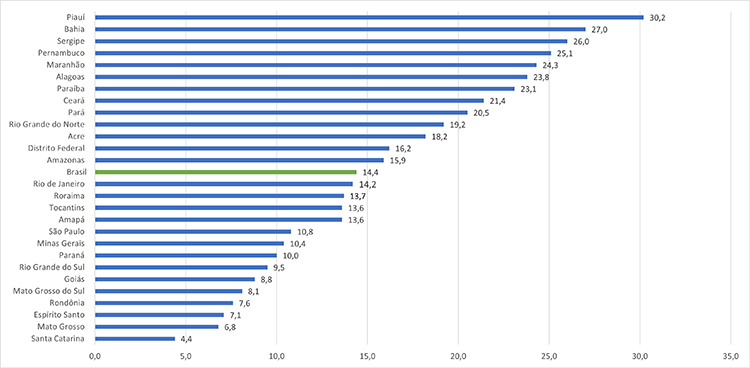
Rondônia has the highest proportion of self-employed persons (35.3%) and Federal District, the lowest (18.6%)
The percentage of the employed population in the country was 25.2. The highest percentages were those of Rondônia (35.3%), Maranhão (31.8%) and e Amazonas (30,4%) and the lowest, of the Federal District (18.6%), Tocantins (20.4%) and Mato Grosso do Sul (21.4%).
Percentage of self-employed persons, by FU (%) - Q2 2025
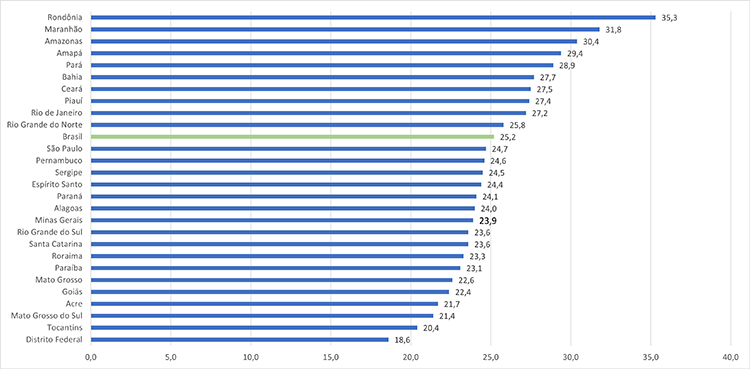
Maranhão has smallest percentage of workers with a formal contract (53.1%) and Santa Catarina, the highest (87.4%)
In Q2 2025, among workers in the private sector in the country, 74.2% had a formal employment contract. The biggest percentages of workers with a formal contract were in Santa Catarina (87.4%), São Paulo (82.9%) and Rio Grande do Sul (81.2%) and the lowest in Maranhão (53.1%), Piauí (54.5%) and Paraíba (54.6%).
Percentage of workers WITH a formal contract in the private sector, by FU (%) - Q2 2025
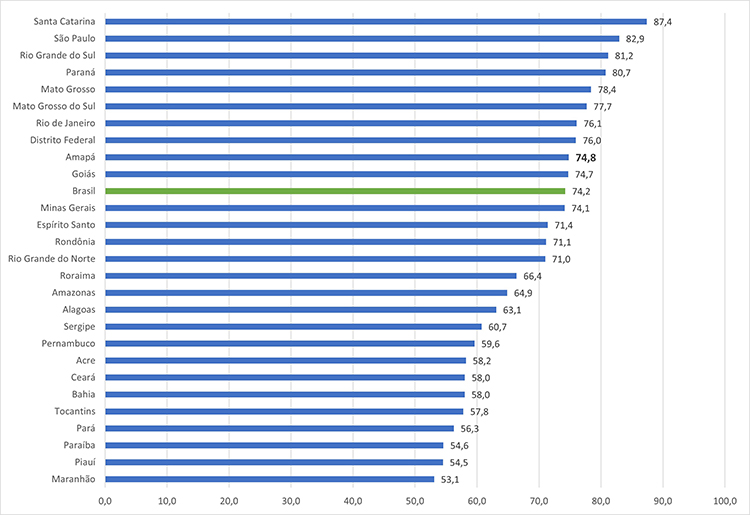
Earnings grows in the Southeast and remains stable in otherMajor Regions
In the second quarter of 2025, the average usual real earnings from all jobs was estimated at R$3,477. There was an increase in both comparisons: against the immediately previous quarter (R$3,440) and also against the same quarter in 2024 (R$3,367).
In the quarterly comparison, the Southeast (R$3,914) was the only Major Region with a statistically significant increase in earnings, while the others remained stable. Against the second quarter of 2024, income growth was observed in the Southeast and South (R$3,880), with statistical stability in both Major Regions.
The total real usual earnings (R$351.2 billion) increased in both comparisons. The Southeast had the highest total real earnings throughout the time series (R$177.8 billion). Against the first quarter of 2025, total earnings grew in four Major Regions, with only the South (R$63.0 billion) remaining stable.
Maranhão (56.2%) has the highest informality rate and Santa Catarina (24.7%), the lowes
The informal employment rate for Brazil was 37.8% of the employed population. The highest rates were those of Maranhão (56.2%), Pará (55.9%), and Bahia (52.3%), and the lowest, of Santa Catarina (24.7%), the Federal District (28.4%), and São Paulo (29.2%).
Informality rate of the employed population, by FU (%) - Q2 2025
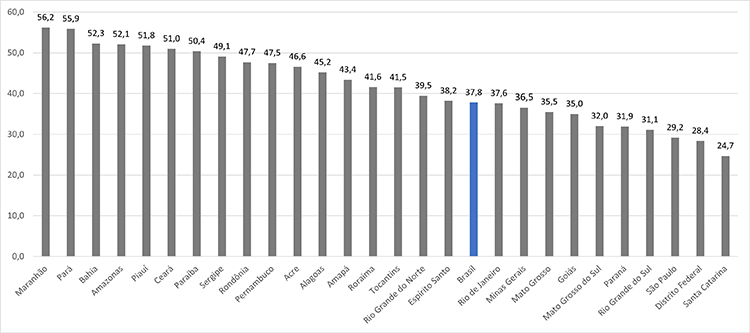
To calculate the proxy for informality rate of the employed population, we consider private sector workers without a formal employment contract, domestic workers without a formal employment contract, workers without a CNPJ (National Register of Legal Entities), self-employed persons without a CNPJ (National Register of Legal Entities), and auxiliary family workers.
Unemployment drops in all job search time ranges against the second quarter of 2024
In the second quarter of 2025, the number of unemployed individuals in the four job search time ranges analyzed by the continuous PNAD (National Household Sample Survey) decreased from the same quarter in the previous year, as shown in the table below.
Furthermore, two of the four search time ranges showed their lowest numbers for a Q2 in the Continuous PNAD time series, which started in 2012. The exceptions were the initial period, of less than a month, which showed only the smallest figure since 2016, and the range of two years or more, with the smallest figure since 2014. In this longer time period, 1.3 million persons had been looking for work for two years or more. This indicator fell 23.6% compared to the second quarter of 2024.
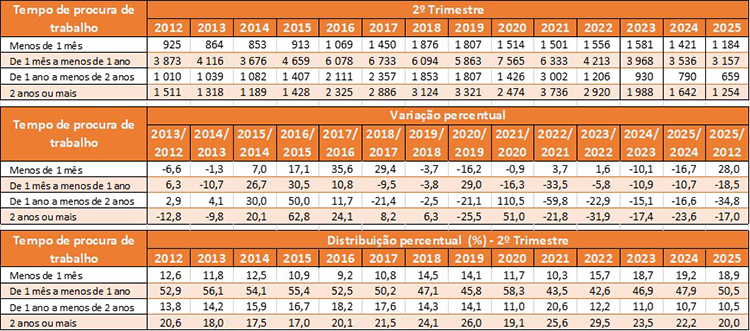
Maranhão has the highest percentage of discouraged workers (9.3%), and Santa Catarina, the lowest (0.3%)
The percentage of discouraged persons (against the workforce or discouraged population) in the country in the first quarter of 2025 was 2.5%. Maranhão (9.3%), Piauí (7.1%), and Alagoas (6.9%) had the highest percentages of discouraged workers, while the lowest were in Santa Catarina (0.3%) and Mato Grosso do Sul (0.8%).
Percentage of discouraged persons in the workforce or discouraged population, by FU (%) - Q2 2025
